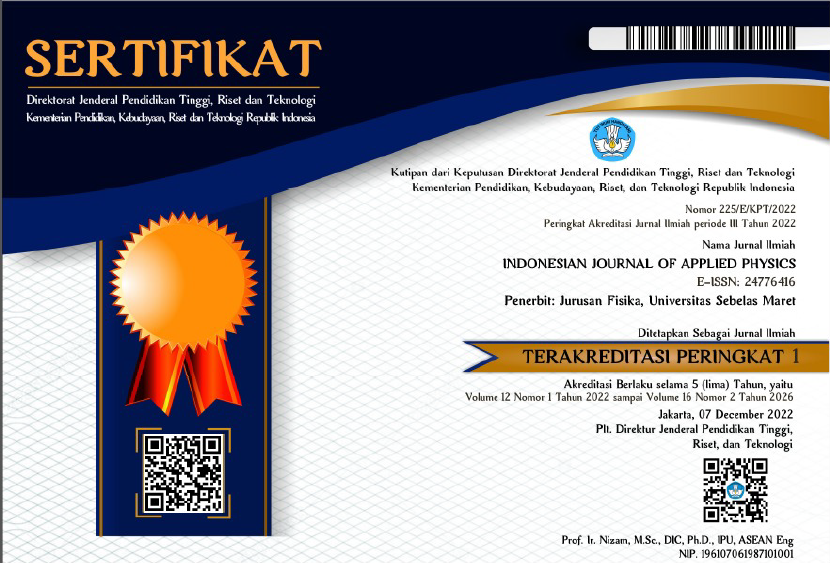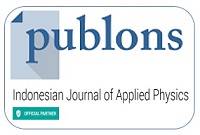Integration of Electrical Resistivity Tomography and Borehole Data for Mapping Laterite-Bedrock Boundaries in a Nickel Deposit, 'PHO' Block, Southeast Sulawesi
Abstract
Indonesia has the largest nickel reserves in the world, so proper exploration is crucial to map the potential and utilization of this resource. Exploration of nickel laterite is carried out by mapping the boundaries of the laterite zone and bedrock as a prospect zone for further exploration. One of the methods used is Electrical Resistivity Tomography (ERT) combined with drill data. The principle of the ERT method involves injecting electric current into the ground to measure variations in subsurface resistivity. These variations in resistivity are then used to map the lithological distribution. ERT data, used as the primary data source to obtain an inversion model, is combined with inline borehole data, involving a total of 8 ERT lines and 23 borehole data points. The integration of both ERT and borehole data characterizes zones of nickel laterite and bedrock. Nickel laterite zones consist of saprolite and limonite lithology, and there is a saprock zone as a transition between the nickel laterite zone and the bedrock. Research in the "PHO" Block shows that resistivity values range from 10.9 Ωm to 1500 Ωm, divided into four main zones: saprolite (<150 Ωm), limonite (150 -700 Ωm), saprock (700 -1000 Ωm), and bedrock (>1000 Ωm). The nickel laterite zones are primarily composed of the saprolite with high Ni, high weathering, and porous zone, limonite zones with high FeO2 and low conductive material, and saprock zones that are transition zones of the nickel laterite with low weathering, high fracture, and bedrock. The boundary between the laterite zone and bedrock is predominantly found at depths ranging from 31.1 meters to over 49.9 meters, indicating the presence of bedrock. The limonite zones, which accumulate to more than 20 meters in thickness, are evenly distributed, with lower accumulations in the south and northeast. Thinner saprolite zones were found at depths exceeding 20 meters, while saprock and bedrock were detected starting from a depth of 13.4 meters and extending to over 49.9 meters. The integration of the ERT method and borehole data provides a clearer understanding of the lithologic distribution and the boundary between the laterite and bedrock zones.
Keywords
Full Text:
PDFReferences
1 Kamaruddin, H., Indrakususma, R. A., Rosana, M. F., Sulaksana, N., & Yuningsih, E. T. (2018). Profil Endapan Laterit Nikel Di Pomalaa, Kabupaten Kolaka, Provinsi Sulawesi Tenggara. Buletin Sumber Daya Geologi, 13(2), 84-105.
2 Loke, M. H. 2004. Tutorial: 2-D and 3-D electrical imaging surveys. Online: www.geoelectrical.com
3 White, R. E. 2016. Geophysical and geochemical integration for mapping nickel laterite deposits. Geophysics, 81(5), B179–B188.
4 Dahlin, T. 2001. The development of DC resistivity imaging techniques. Computers & Geosciences, 27(9), 1019-1029.
5 Wicaksono, M. A., Mordekhai, D. S., & Rahmat, A. S. 2023. Integrating Resistivity and Geochemical Component Data with Bayesian Inference to Characterize Nickel Laterites: A Case Study from Pomalaa Region Using Large-Scale Borehole Data. hand, 23, 26th.
6 Soh Tamehe, L., Zhao, Y., Xu, W., & Gao, J. 2024. Ni (Co) Laterite Deposits of Southeast Asia: A Review and Perspective. Minerals, 14(2), 134.
7 Suryawan, E. H., Hilyah, A., Fajar, M. H. M., & Pajrin, A. 2019. Identifikasi Dan Penentuan Volume Endapan Nikel Laterit Berdasarkan Data Geolistrik Metode Sounding Studi Kasus Blok Selatan Daerah Pomalaa, Sulawesi Tenggara. Jurnal Geosaintek, 5(2), 53-60.
8 Ministry of Energy and M. Resources. 2020. Indonesia’s Nickel Resources.
9 Nugraha, A. M. S., Hall, R., & BouDagher-Fadel, M. 2022. The Celebes Molasse: A revised Neogene stratigraphy for Sulawesi, Indonesia. Journal of Asian Earth Sciences, 228, 105140.
10 Nugraha, A. M. S., Hall, R., BouDagher‐Fadel, M., Todd, J. A., & Switzer, A. D. 2023. Neogene history of fluvial to shallow marine successions in the Kendari Basin, SE Sulawesi, Indonesia. The Depositional Record, 9(2), 300-334.
11 Aswad, S., & Mais, D. M. 2018. ERT and Well Data Tie for Nickel Laterite Characterization. In IOP Conference Series: Earth and Environmental Science, 132(1), 012024. IOP Publishing.
12 Hellman, K., Johansson, S. J., Olsson, P. O., & Dahlin, T. D. 2016. Resistivity inversion software comparison. In Near Surface Geoscience 2016-22nd European Meeting of Environmental and Engineering Geophysics, 2016(1), cp-495). European Association of Geoscientists & Engineers.
13 Putri, H. S. 2023. Identifikasi persebaran mineral silika menggunakan metode geolistrik konfigurasi pole-dipole dengan pemodelan 2d kota kolaka, sulawesi tenggara (Bachelor's thesis, Fakultas Sains dan Teknologi UIN Syarif HIdayatullah Jakarta).
14 Masri, M., Mili, M. Z., Awaliah, W. R., Tugo, L. J., & Rifai, L. A. 2023. Mineralogi dan Properti Keteknikan Endapan Nikel Laterit Daerah Tobimeita-Langgikima, Kabupaten Konawe Utara, Sulawesi Tenggara. Jurnal GEOSAPTA, 9(2), 117-125.
15 Maulana, A. 2017. Endapan Mineral. Universitas Hassanudin.
16 Zhang, Y., Qie, J., Wang, X. F., Cui, K., Fu, T., Wang, J., & Qi, Y. 2020. Mineralogical characteristics of the nickel laterite, southeast ophiolite belt, Sulawesi Island, Indonesia. Mining, Metallurgy & Exploration, 37(1), 79-91.
Refbacks
- There are currently no refbacks.
















